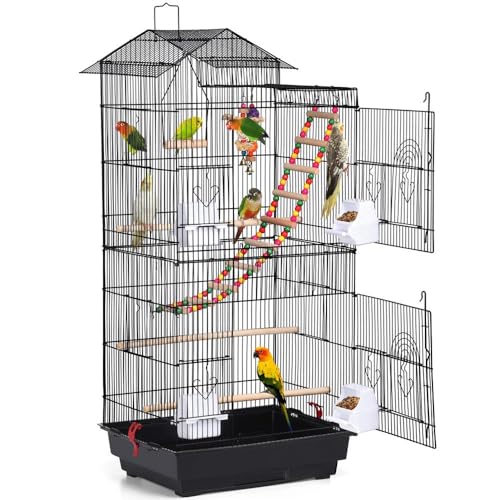Plum-headed Parakeet: A Comprehensive Guide
The Plum-headed Parakeet (Psittacula cyanocephala) is a captivating and colorful bird native to the Indian subcontinent. Known for its striking plumage and playful nature, this parakeet is a favorite among bird enthusiasts and pet owners. In this article, we will delve into the various aspects of the Plum-headed Parakeet, including its physical characteristics, natural habitat, behavior, diet, breeding, and care as a pet.

Our Favorite Parakeet Supplies & Toys
Advertisement
These are literally the 4 most used items we have found on amazon for our bird. Must haves!
As an Amazon Associate I earn from qualifying purchases.
Plum-headed Physical Characteristics
There are few things that really make the Plum-headed birds standout.
Size and Weight of the Plum-headed
The Plum-headed Parakeet is a medium-sized parakeet, measuring approximately 33 cm (13 inches) in length, including its long tail. It weighs around 70-80 grams.
Plum-headed Plumage
The most distinctive feature of the Plum-headed Parakeet is its vibrant head coloration. Males have a deep purple or plum-colored head, while females display a more subdued, greyish-blue hue. Both sexes have a striking black neck ring and a green body with a bluish-green back. The wings are adorned with a bright green color and a touch of yellow on the underside. The tail is long and tapered, with a mix of blue and green feathers and a yellow tip.
Beak and Eyes
The beak of the Plum-headed Parakeet is orange-red, strong, and slightly curved, ideal for cracking seeds. Their eyes are a pale yellow, giving them an alert and inquisitive expression.
Plum-headed Natural Habitat
Geographic Range
The Plum-headed Parakeet is native to the Indian subcontinent, including India, Pakistan, Sri Lanka, and parts of Nepal and Bhutan. They are commonly found in forested areas, woodlands, and open countryside.
Preferred Environment
These parakeets thrive in a variety of habitats, from deciduous and evergreen forests to cultivated areas and gardens. They are often seen in large flocks, especially in regions with an abundance of food sources.
The plum-headed flock to the right is foraging for food on a tree branch.

Parakeet Cages – What cage works best?
Advertisement
The more room the better! A parakeet should be able to fly both horizontally and vertically in a spacious cage.
As an Amazon Associate I earn from qualifying purchases.
Plum-headed Behavior
Social Structure
Plum-headed Parakeets are highly social birds, often forming large flocks outside the breeding season. These flocks can consist of hundreds of individuals, providing safety in numbers and an efficient way to locate food.
Communication
They are vocal birds, using a range of calls and sounds to communicate. Their calls include loud screeches and softer chattering, used for flock coordination, mating, and alerting others to potential threats.
Daily Activities
These parakeets are diurnal, meaning they are active during the day. Their day typically involves foraging for food, socializing with flock members, preening, and resting in shaded areas.

Plum-headed Breeding
Breeding Season
The breeding season for Plum-headed Parakeets varies depending on their geographic location but generally occurs between December and April.
Nesting
These parakeets typically nest in tree cavities or artificial nest boxes. The female lays a clutch of 3-6 eggs, which she incubates for about 23-24 days.
Rearing Chicks
Once the chicks hatch, both parents are involved in feeding and caring for them. The chicks fledge at around 6-7 weeks of age but continue to be fed by the parents for a few more weeks until they are fully independent.
Plum-headed Diet
Natural Diet
In the wild, Plum-headed Parakeets have a varied diet that includes seeds, fruits, berries, nuts, and blossoms. They are known to feed on crops like millet, maize, and rice, which sometimes brings them into conflict with farmers.
Captive Diet
When kept as pets, it is important to provide a balanced diet that mimics their natural food intake. A high-quality parakeet seed mix, supplemented with fresh fruits and vegetables, is ideal. Some suitable fruits and vegetables include apples, pears, grapes, carrots, and leafy greens. Additionally, cuttlebone should be provided to ensure adequate calcium intake.
Care as Pets of the Plum-headed
Housing
Plum-headed Parakeets require a spacious cage to accommodate their active nature. The cage should be at least 24 x 24 x 36 inches, with horizontal bars for climbing. Providing a variety of perches, toys, and swings can help keep them entertained and mentally stimulated.
Social Interaction
As social birds, Plum-headed Parakeets thrive on interaction with their owners and other birds. Regular playtime outside the cage, training sessions, and gentle handling can help build a strong bond between the bird and its owner.
Health and Well-being
Maintaining a clean living environment, a balanced diet, and regular veterinary check-ups are crucial for the health of Plum-headed Parakeets. They are generally hardy birds but can be prone to respiratory infections, feather plucking, and nutritional deficiencies if not properly cared for.
Plum-headed Parakeets are Delightful
The Plum-headed Parakeet is a delightful parakeet breed and visually stunning bird that makes a wonderful pet for bird enthusiasts. With their vibrant plumage, social nature, and engaging personality, they bring joy and companionship to their owners. Understanding their natural behavior, dietary needs, and care requirements is essential for ensuring a happy and healthy life for these beautiful birds. Whether observed in the wild or kept as a pet, the Plum-headed Parakeet is a testament to the incredible diversity and beauty of the avian world.









